 Adam Johnson
.
July 06, 2022
.
Uncategorized
Adam Johnson
.
July 06, 2022
.
Uncategorized
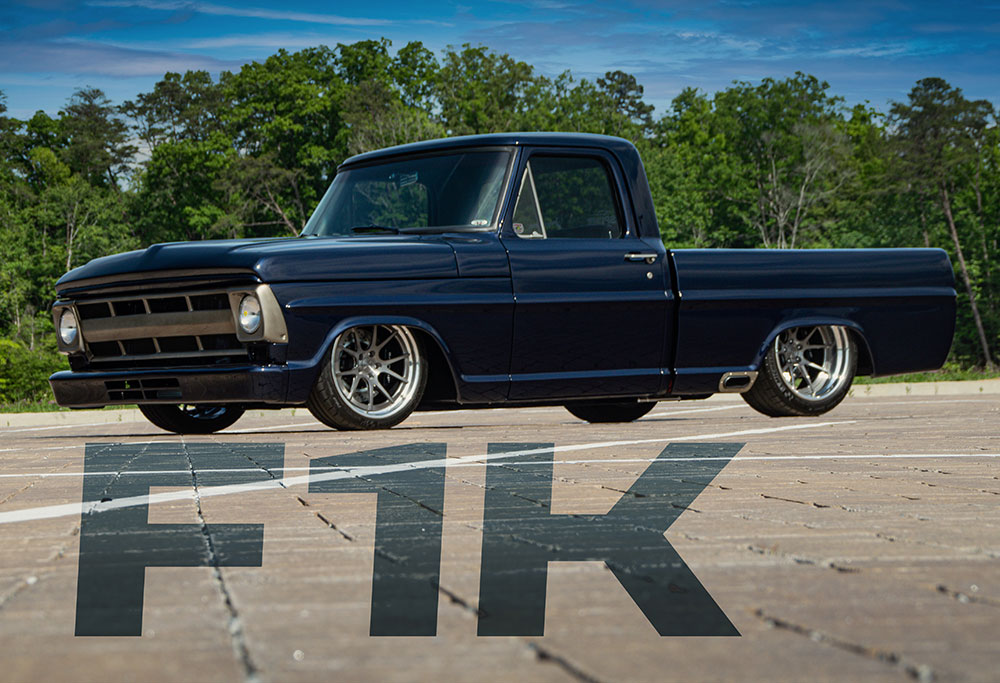
“F1K” is the perfect name for this 1972 F-100. How did we come up with it? Well, it’s an F-100 with 1,000 horsepower. Easy enough!
John Jinnings is a lifelong enthusiast of building custom vehicles. He has personally owned 156 automobiles, with about 25 of them being magazine worthy. John found a rust-free ’72 Ford F-100 on eBay in California, and once the deal was done and the truck shipped to Indiana, they stripped it down to just what was needed and sold everything else off.
With the power the motor was going to have, a stock frame would twist like a pretzel, so John went with a Roadster Shop Fast Track chassis with a 4-inch drop built in. He used a 4-link on the rear with Penske shocks to hold the rear end in place, and tubular A-arms with Corvette spindles and Penske shocks up front. For stopping on a dime, Baer six-piston disc brakes on all four corners with 14-inch pistons up front and 13-inch pistons on the rear do the trick. To finish off the rolling chassis, 19×9 Forgeline rims up front and 20×12 Forgeline rims at the rear keep “F1K” planted to the ground with sticky Michelin rubber.
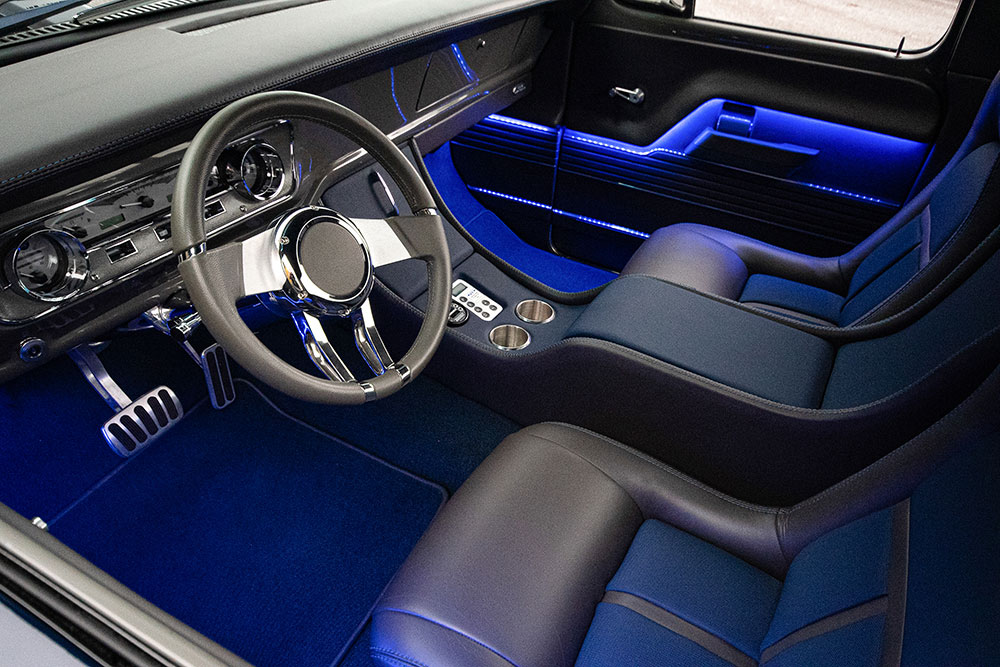
For all the power, John contacted Hellion Power Systems to see if the crew there could produce a 1,000-horsepower motor. They assured him they could! Starting with a 2014 Ford 5.0L Coyote engine, they had Holbrook Racing Engines machine the engine to spec, and Brenspeed then assembled every part. To achieve 1,000 horsepower, Hellion added a pair of 62mm twin turbos with an air-to-air-intercooler, boost controller, a Sniper throttle body intake, and a Turbonetics Performance wastegate with pop-off valves. Three-inch powdercoated Hellion headers dump exhaust gases out through the Magnaflow mufflers that exit in front of the rear wheels.
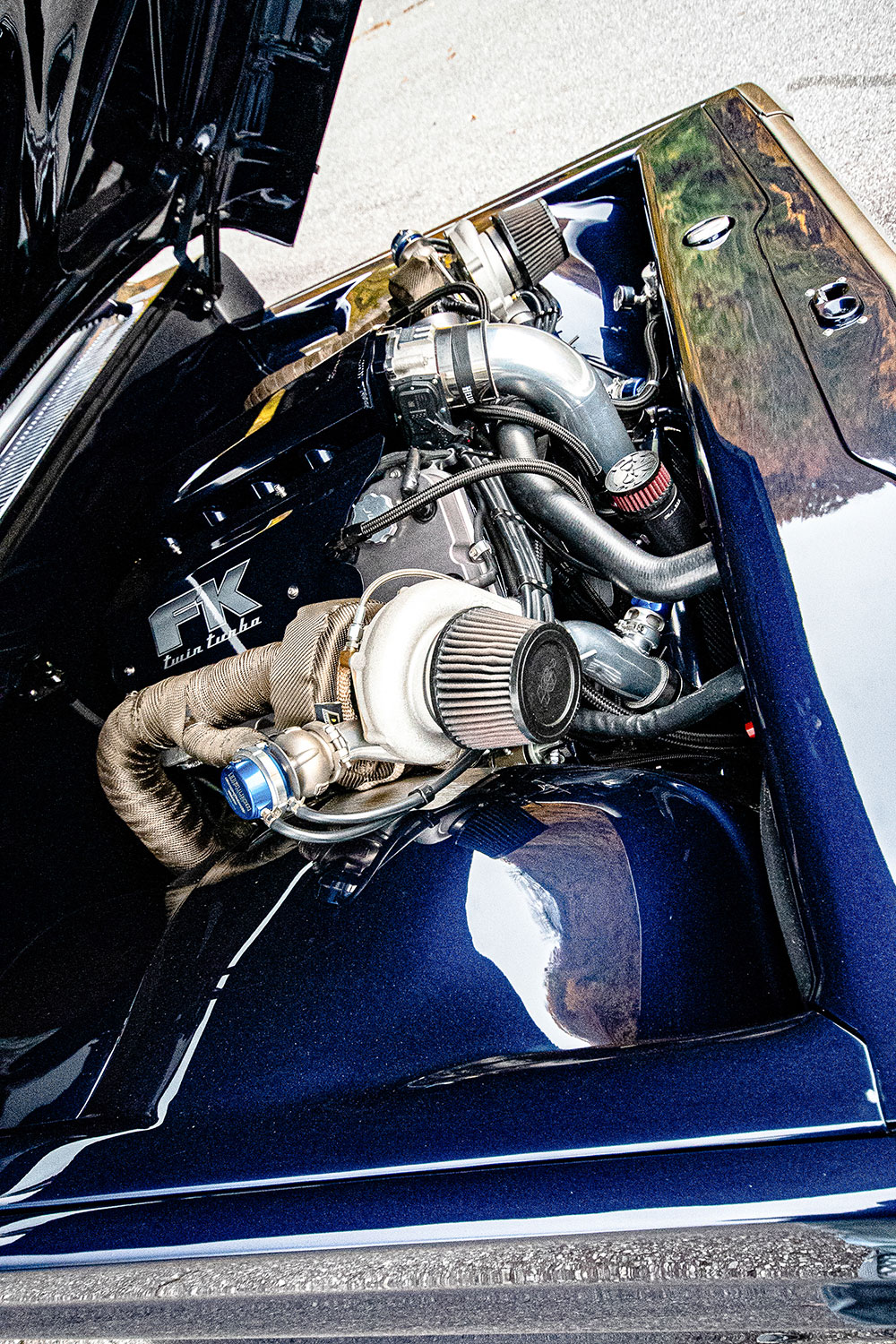 Because everything is clean and simple, they decided to hide the master cylinder under the dash and fit custom panels with false compartments on the inner fenders to hold the boost controller on one side and PCM on the other. Keeping with the clean theme, all hoses and wires were routed under the Sniper intake, and custom engine covers were made to hide the coil packs. To help keep the massive engine cool, there’s a 25×19 custom radiator from Ace Radiator. A 4R70W 4-speed automatic transmission with a billet converter and a 2800 stall was then bolted on to the backside of the engine. A Speedway aluminum 9-inch rear-end running 3:70 gears with posi-traction and Strange axles allow all 1,000 horses to hook to the ground.
Because everything is clean and simple, they decided to hide the master cylinder under the dash and fit custom panels with false compartments on the inner fenders to hold the boost controller on one side and PCM on the other. Keeping with the clean theme, all hoses and wires were routed under the Sniper intake, and custom engine covers were made to hide the coil packs. To help keep the massive engine cool, there’s a 25×19 custom radiator from Ace Radiator. A 4R70W 4-speed automatic transmission with a billet converter and a 2800 stall was then bolted on to the backside of the engine. A Speedway aluminum 9-inch rear-end running 3:70 gears with posi-traction and Strange axles allow all 1,000 horses to hook to the ground.
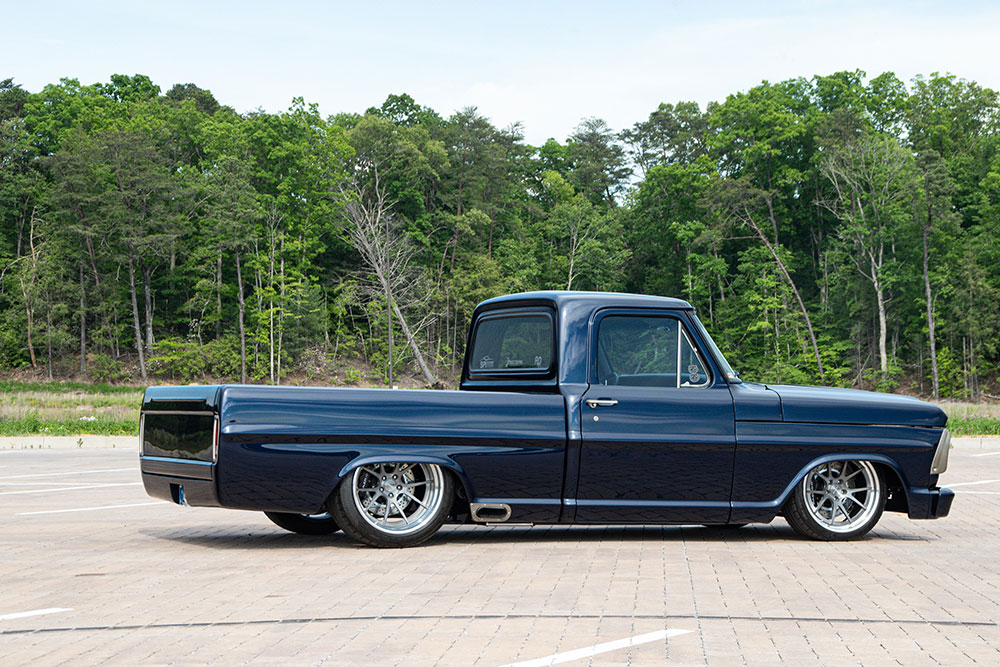 Minimal Body Mods
Minimal Body ModsThe body mods were minimal with the perfect touches. The bed floor was raised 4 inches, tailgate smoothed and corners were radiused. Completing the bed, wheel tubs were added to accept the much wider tires. Four slots were cut into the front bumper and grille to allow extra air into the intercooler, and the wheels, grille and door handles were powdercoated gray. The body was then smoothed to perfection and painted Axalta BMW Tanzanite blue.
To complete the build, Steve Holcomb of Pro Auto Customs in Knoxville, Tennessee, covered everything inside in light gray and blue leather. The smoothed dash has a ’64 Falcon gauge panel outfitted with Dakota Digital gauges. An Ididit column holds the Flaming River steering wheel, and backlit blue LED lights were placed in the headliner, door panels, and under the dash.
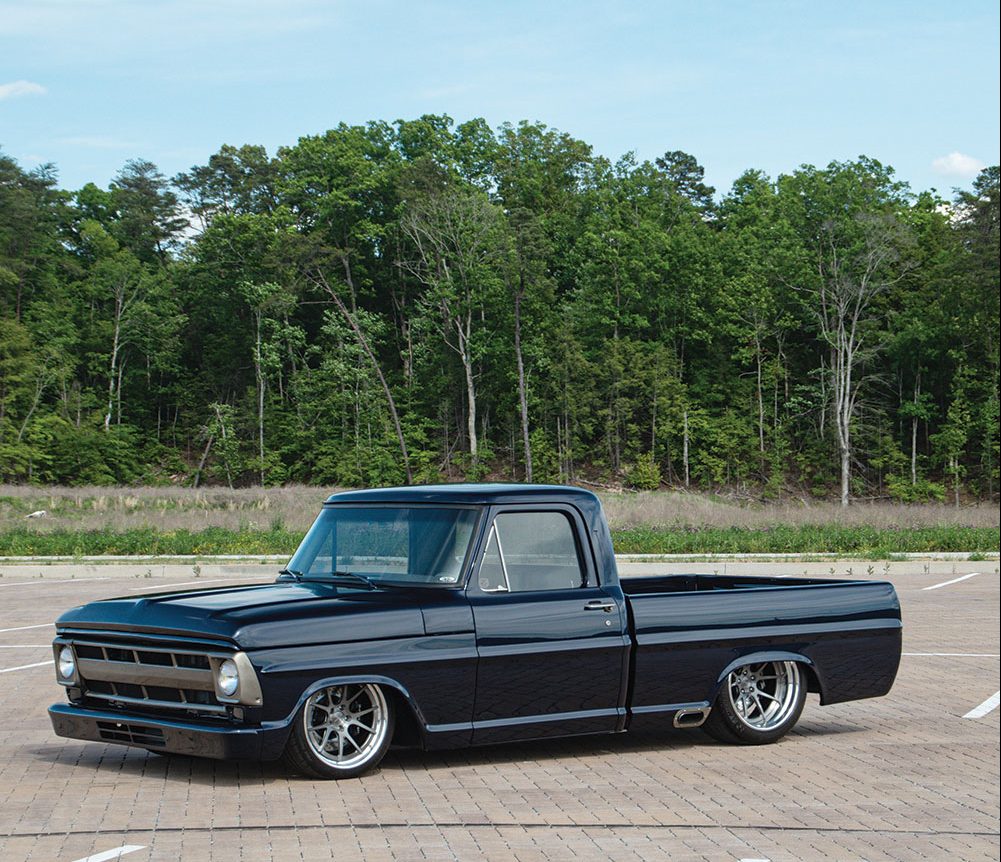 Many Thanks …
Many Thanks …John would like to thank his family, Steve Holcomb for the interior, Kevin Riffey for bodywork, Kyle Mullenhour for the paintwork, and Rusty Iron Restorations.
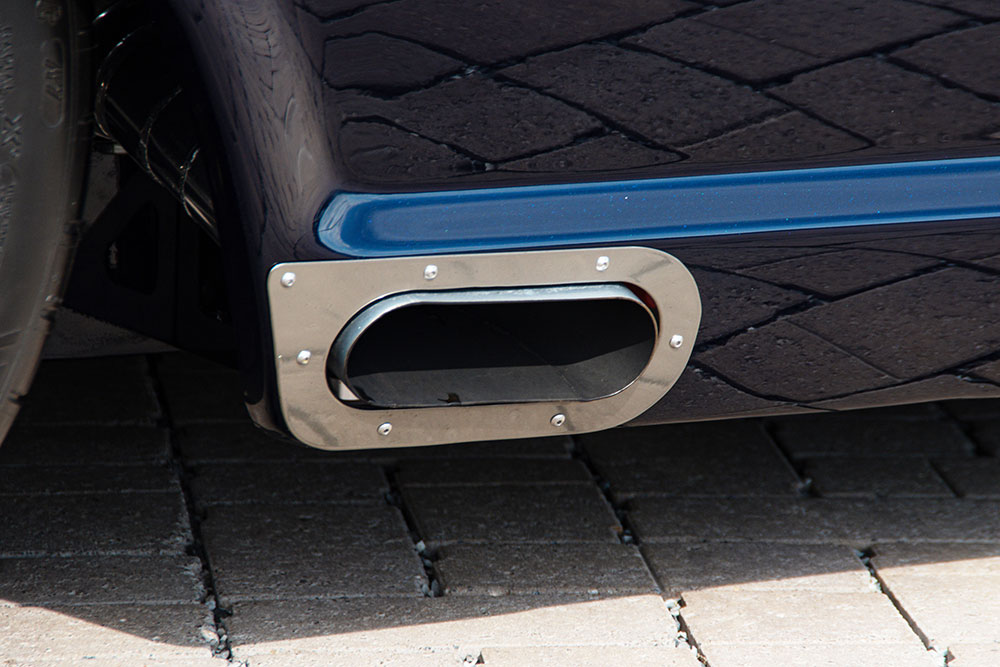
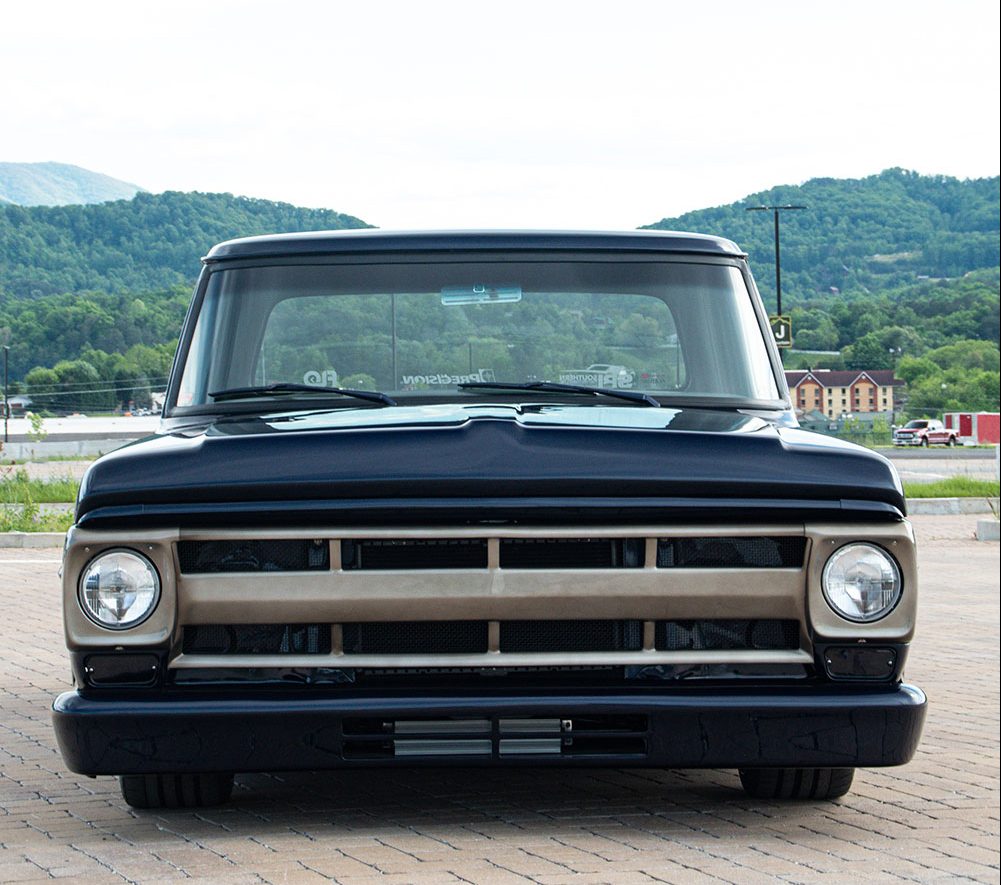
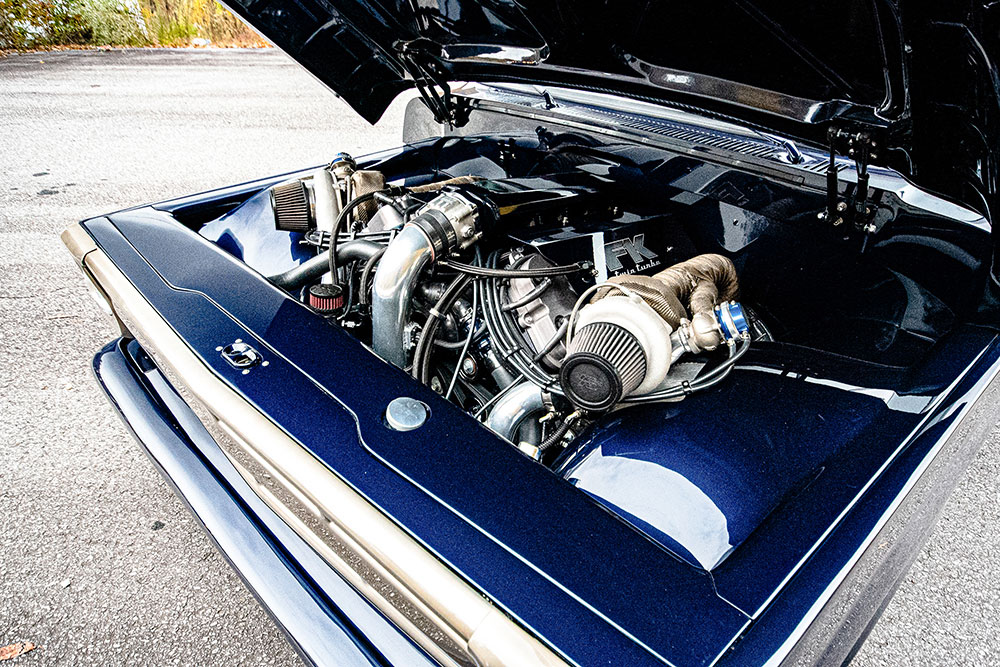
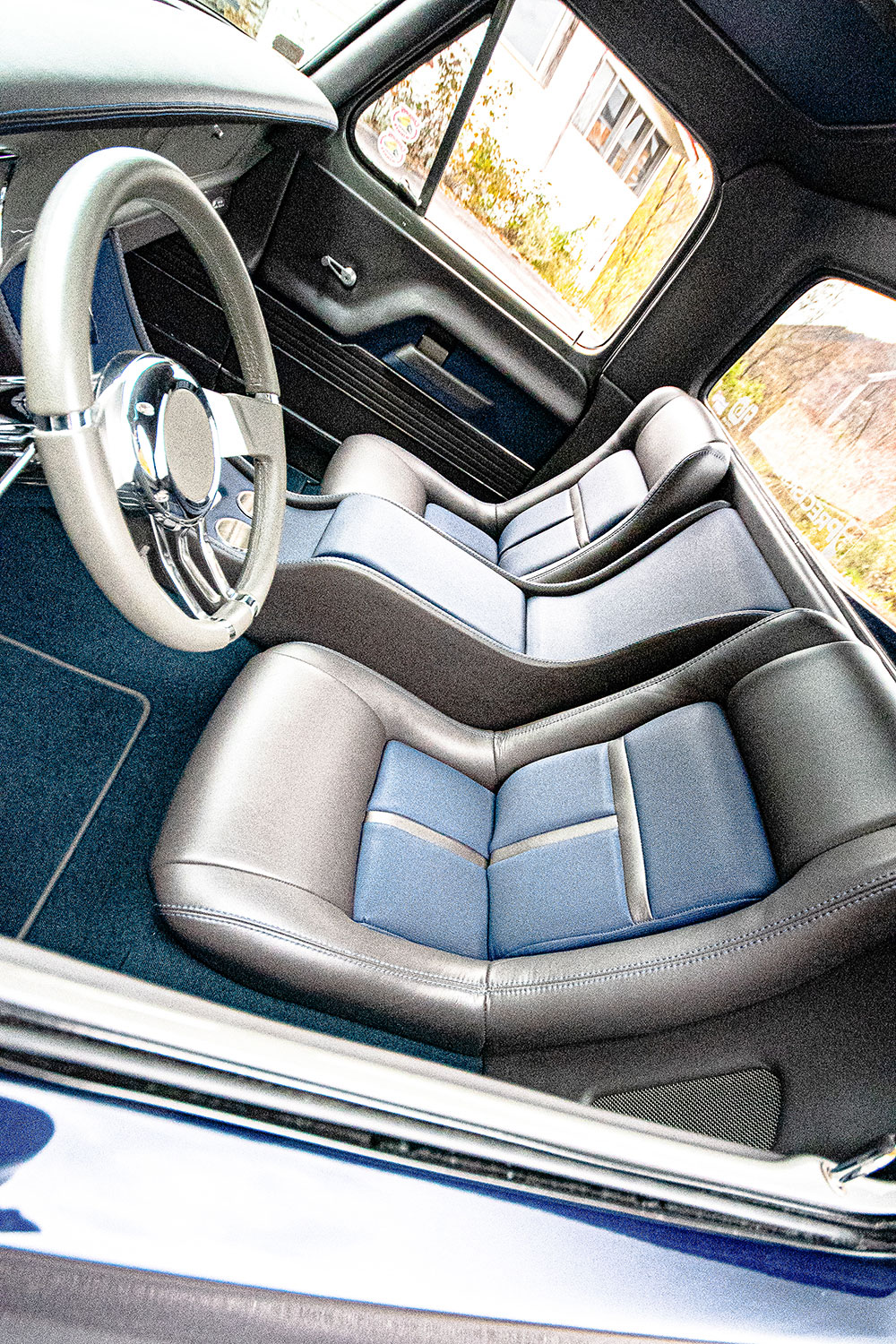
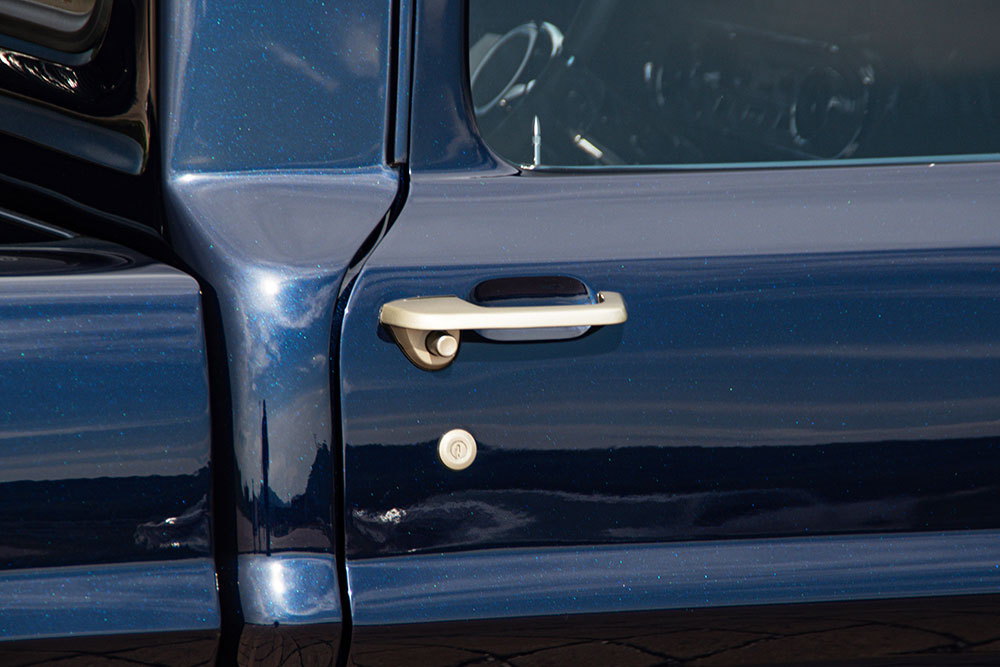
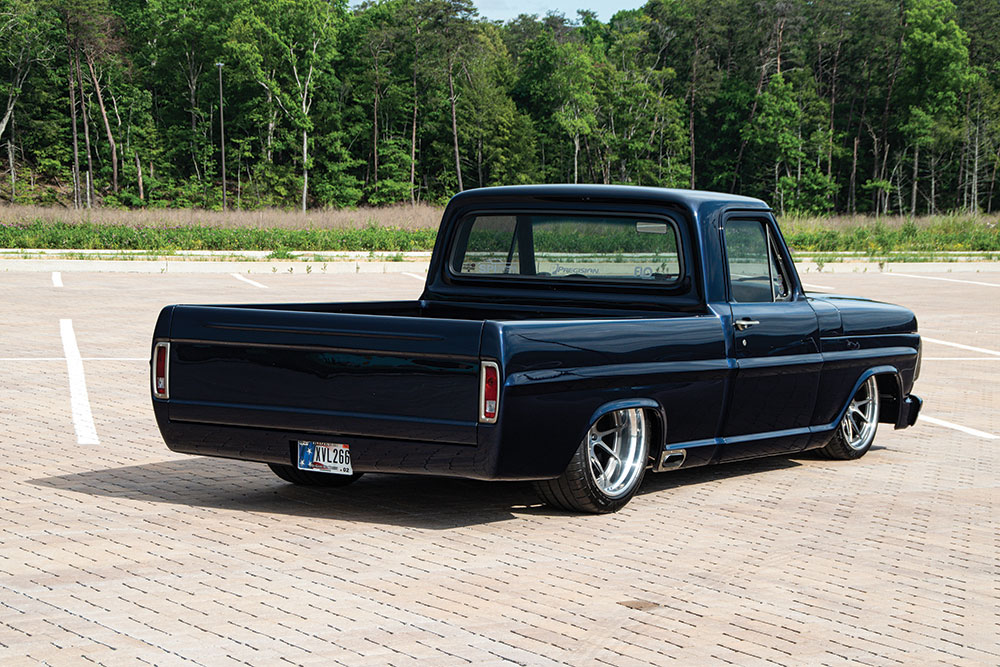
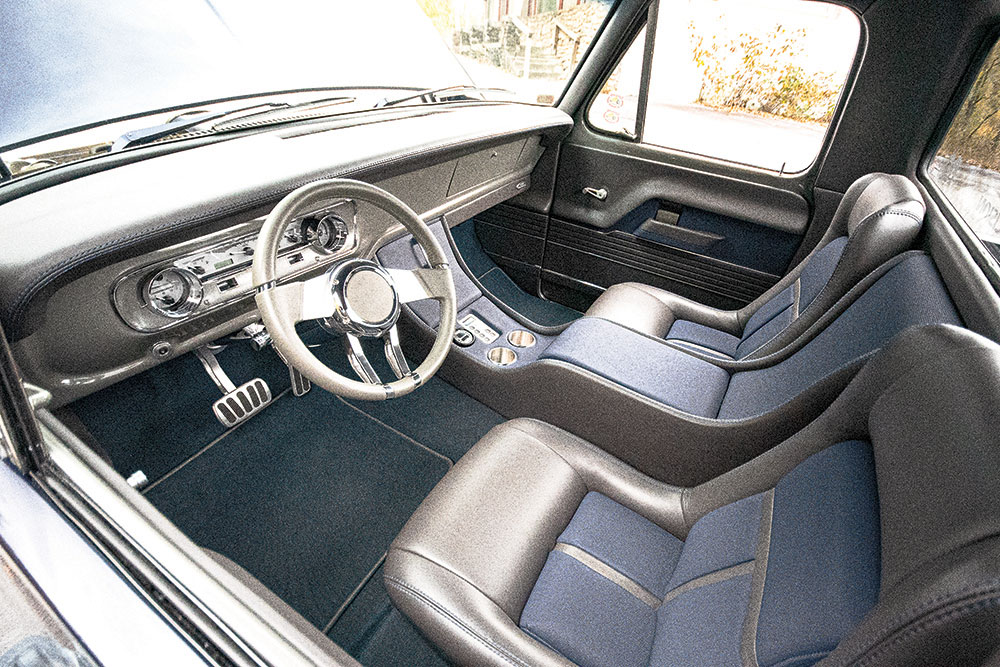
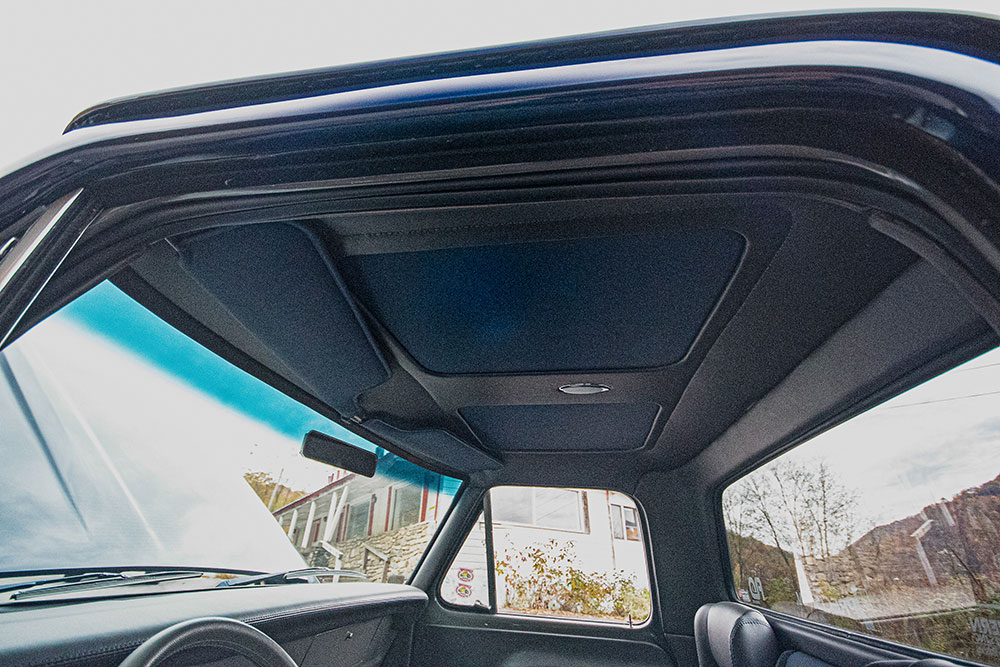
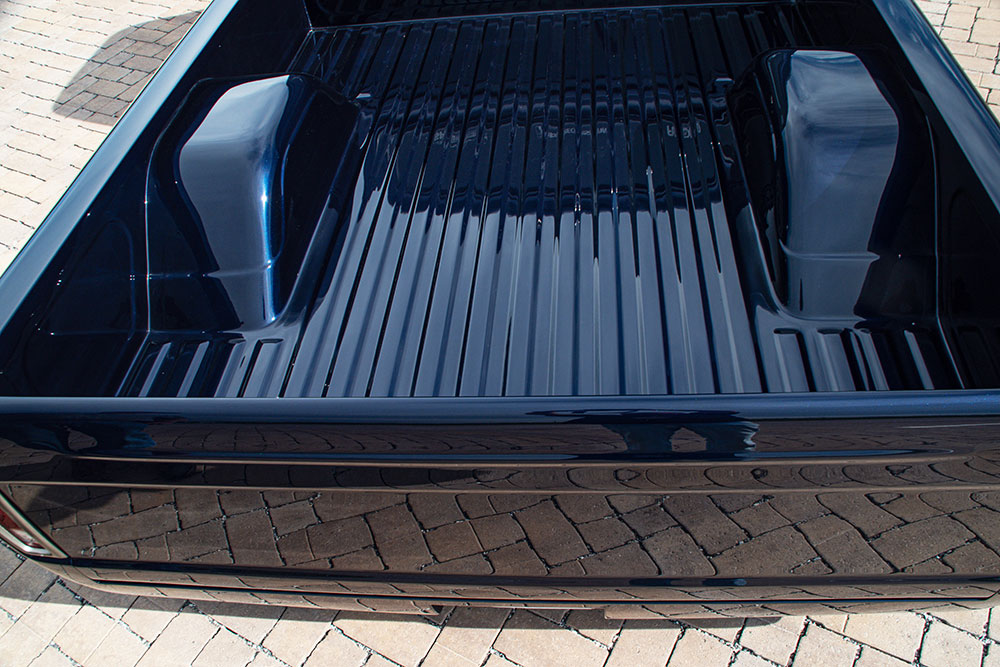
What were the paint color options for the 1972 Ford F-100?
When choosing a paint color for the 1972 Ford F-100, you had a variety of options that could match your style and preferences. Here are the available colors with their respective codes:
These wide-ranging colors offered something for every taste, from subtle tones to vivid hues. Whether you wanted your truck to stand out or blend in, the 1972 Ford F-100 had a suitable option.
What parts and accessories are available for restoring or modifying a fifth-generation Ford F-100?
Restoring or modifying a fifth-generation Ford F-100? Whether you’re diving into a full restoration or adding the final touches to your project, you’ll find an extensive range of parts and accessories to meet your needs.
Whether you’re replacing worn-out components or aiming to optimize performance, these parts and accessories offer everything you need to turn your fifth-generation Ford F-100 into a true masterpiece.
What factors should be considered when selecting a fifth-generation Ford F-100?
When choosing a fifth-generation Ford F-100, several key factors should guide your decision:
By thoroughly evaluating these factors, you’ll be better equipped to choose a fifth-generation Ford F-100 that not only meets your needs but also preserves the vehicle’s classic charm and value.
How is the fifth-generation Ford F-100 depicted in popular media?
The fifth-generation Ford F-100 has cemented its place in pop culture, thanks to its memorable appearances in various films and TV shows. One notable depiction is in the 2007 film No Country for Old Men, where the truck plays a crucial role in an intense escape scene. The protagonist, Llewelyn Moss, uses a commandeered 1971 F-100in a desperate bid to flee from the antagonist, Anton Chigurh. This sequence showcases the F-100’s ruggedness and reliability under pressure.
Beyond No Country for Old Men, the fifth-generation F-100 often appears in period pieces to evoke a sense of nostalgia and authenticity. Its classic design makes it a favorite among filmmakers aiming to recreate the look and feel of 1970s America. The truck has also been featured in various TV shows and commercials, reinforcing its iconic status.
The fifth-generation Ford F-100 continues to be celebrated in pop culture, symbolizing both the era it was manufactured in and the durability of classic American trucks.
How did Ford’s marketing reflect the changes in the F-100’s design and purpose?
In the evolution of its pickup trucks, Ford made a deliberate shift in both design and marketing strategy, transforming the F-100 into a vehicle that catered to more than just work requirements. Initially, pickups were straightforward workhorses, focused on durability and utility. However, as consumer needs evolved, Ford integrated features that offered enhanced comfort, blurring the line between utility vehicles and daily drivers.
Ford’s advertising began to highlight the luxurious and car-like aspects of their trucks, a reflection of their new design philosophy. Campaigns often featured slogans emphasizing this dual nature, suggesting that the F-100 not only performed rugged tasks but also provided a smooth and comfortable ride. Phrases like “Works like a truck. Rides like a car.” encapsulated this dual-purpose ethos, appealing to a broader audience beyond traditional work users.
Promotional materials from this era showcased interior comforts and advanced features alongside the truck’s robust capabilities. Brochures and advertisements frequently contained images of plush interiors, advanced dashboards, and spacious cabins, signaling a shift towards a more refined driving experience. This strategy not only aimed to attract new demographics but also retained traditional users by highlighting that these new comforts did not compromise the truck’s essential toughness.
This change in marketing strategy mirrored broader industry trends where light trucks began to serve dual roles. Ford’s move was part of a larger movement where pickups were increasingly seen as viable options for both work and everyday life. Although these early models were not as technologically advanced or luxurious as the pickups we see today, they laid the groundwork for future innovations.
By integrating both utility and comfort in their messaging, Ford successfully communicated the F-100’s expanded role, appealing to a variety of consumers and setting the stage for the multifunctional trucks of the modern era.
What was the overall philosophy behind the design and utility of the Ford F-100?
The overarching philosophy of the Ford F-100’s design revolved around practicality and reliability. Despite evolving aesthetics over the years — shifting from a classic, curvaceous style to a more squared-off and rigid look — the core principles stayed the same.
In essence, the Ford F-100 was designed with a steadfast commitment to delivering practical solutions, ensuring that owners had a trustworthy tool for getting things done.
What were the paint color options for the 1971 Ford F-100?
If you’re restoring or simply curious about the 1971 Ford F-100, you’ll be pleased to know that it came with a variety of captivating exterior paint colors. Here’s a comprehensive list of the color choices available for that model year:
These colors ensured that buyers could find a shade to match their personal style, from subdued classics to vibrant, attention-grabbing hues. Whether you’re looking to restore a 1971 Ford F-100 to its original glory or simply appreciate vintage automotive aesthetics, these paint options provide a snapshot of the era’s diverse palette.
What were the specifications for the 1971 Ford F-100?
The 1971 Ford F-100 is a notable classic, known for its robust build and diverse range of options. Below, you’ll find a comprehensive breakdown of its specifications:
The 1971 Ford F-100 came in an array of eye-catching colors. Here are some of the available paint codes:
These specifications highlight the 1971 Ford F-100’s blend of power, versatility, and style. Ideal for collectors and enthusiasts alike, this vehicle remains a symbol of rugged durability.
How did the design of the Ford F-100 change from previous generations?
The design of the Ford F-100 underwent notable changes as it evolved from its earlier generations. Initially, the model showcased a classic, curvy aesthetic that was both visually appealing and symbolic of the era’s design ethos. However, as time progressed, the truck adopted a more squared-off and rigid appearance. These adjustments reflected a shift towards a modern, utilitarian look while maintaining the vehicle’s core identity as a practical and reliable workhorse.
The Ford F-100’s design journey from its curvy beginnings to a more rigid, squared-off style encapsulates the broader trends in vehicle design and consumer expectations. While the core philosophy of practicality and reliability remained unaltered, the incorporation of modern comforts and aesthetic changes ensured the truck’s relevance across generations.
What were the specifications for the 1972 Ford F-100?
“F1K” is the perfect name for this 1972 F-100. How did we come up with it? Well, it’s an F-100 with 1,000 horsepower. Easy enough!
With the power the motor was going to have, a stock frame would twist like a pretzel, so John went with a Roadster Shop Fast Track chassis with a 4-inch drop built in. He used a 4-link on the rear with Penske shocks to hold the rear end in place, and tubular A-arms with Corvette spindles and Penske shocks up front. For stopping on a dime, Baersix-piston disc brakes on all four corners with 14-inch pistons up front and 13-inch pistons on the rear do the trick. To finish off the rolling chassis, 19×9 Forgeline rims up front and 20×12 Forgeline rims at the rear keep “F1K” planted to the ground with sticky Michelin rubber.
For all the power, John contacted Hellion Power Systems to see if the crew there could produce a 1,000-horsepower motor. They assured him they could! Starting with a 2014 Ford 5.0L Coyote engine, they had Holbrook Racing Engines machine the engine to spec, and Brenspeed then assembled every part. To achieve 1,000 horsepower, Hellion added a pair of 62mm twin turbos with an air-to-air-intercooler, boost controller, a Sniper throttle body intake, and a Turbonetics Performance wastegate with pop-off valves. Three-inch powdercoated Hellion headers dump exhaust gases out through the Magnaflow mufflers that exit in front of the rear wheels.
Because everything is clean and simple, they decided to hide the master cylinder under the dash and fit custom panels with false compartments on the inner fenders to hold the boost controller on one side and PCM on the other. Keeping with the clean theme, all hoses and wires were routed under the Sniper intake, and custom engine covers were made to hide the coil packs. To help keep the massive engine cool, there’s a 25×19 custom radiator from Ace Radiator. A 4R70W 4-speed automatic transmission with a billet converter and a 2800 stall was then bolted on to the backside of the engine. A Speedway aluminum 9-inch rear-end running 3:70 gears with posi-traction and Strangeaxles allow all 1,000 horses to hook to the ground.
The body mods were minimal with the perfect touches. The bed floor was raised 4 inches, tailgate smoothed and corners were radiused. Completing the bed, wheel tubs were added to accept the much wider tires. Four slots were cut into the front bumper and grille to allow extra air into the intercooler, and the wheels, grille and door handles were powdercoated gray. The body was then smoothed to perfection and painted Axalta BMW Tanzanite blue.
To complete the build, Steve Holcomb of Pro Auto Customs in Knoxville, Tennessee, covered everything inside in light gray and blue leather. The smoothed dash has a ’64 Falcon gauge panel outfitted with Dakota Digital gauges. An Ididit column holds the Flaming River steering wheel, and backlit blue LED lights were placed in the headliner, door panels, and under the dash.
Before diving into the modifications, let’s take a look at the original specs for the 1972 Ford F-100, which serve as a foundation for this powerful build:
Spec 1972 Ford F-100 Starting MSRP $2,550 (about $18,814 when adj. For inflation) Engines 240 ci I6, 300 ci I6, 302 ci V8, 360 ci V8, 390 ci V8 Horsepower 140 hp, 165 hp, 205 hp, 215 hp, 255 hp Torque 230 lb-ft, 294 lb-ft, 300 lb-ft, 327 lb-ft, 376 lb-ft Transmission 3-speed manual, 3-speed manual plus Overdrive, 4-speed “Cruiseomatic” automatic Base Curb Weight 3,540 lbs (short bed, styleside)/3,740 lbs (long bed, styleside) Length 182.5 inches/202.3 inches Wheelbase 115.0 inches/131.0 inches Bed Length 6.5 feet or 8 feet Fuel Tank Capacity 19.5 gallons Wheel Size 15 inch (16 inch optional) ### Exterior Paint Colors
The 1972 Ford F-100 came in a variety of eye-catching colors:
Color Code Sample Notes Wind Blue B Pure White C Chrome Yellow G Prairie Yellow K Wimbledon White M Seapine Green Metallic O Winter Green Q Sequoia Brown R Candyapple Red T Mallard Green V Saddletan W Calypso Coral 1 Royal Maroon 2 Swiss Aqua 3 Bahama Blue 6 Tampico Yellow 8 By blending the original specs with the modern modifications, we get a full picture of the amazing transformation from a classic 1972 Ford F-100 to the beastly “F1K” that stands before us today.
What changes were made to the 1972 Ford F-100?
The body mods were minimal with the perfect touches. The bed floor was raised 4 inches, tailgate smoothed and corners were radiused. Completing the bed, wheel tubs were added to accept the much wider tires. Four slots were cut into the front bumper and grille to allow extra air into the intercooler, and the wheels, grille, and door handles were powder-coated gray. The body was then smoothed to perfection and painted Axalta BMW Tanzanite blue.
As with the previous model year, there were few overall changes as the fifth generation came to a close. However, significant upgrades were made to enhance performance and durability:
These mechanical and package upgrades ensured that the vehicle was not only aesthetically pleasing but also capable of superior performance in various conditions.
Share Link